Legal aid statistics England and Wales bulletin Jan to Mar 2023
Updated 17 July 2023
Applies to England and Wales
We are seeking user feedback on the use of HTML for the publication of statistical bulletins. Please send any comments to: statistics@justice.gov.uk.
Main Points
| Representation orders granted in magistrates’ court increased 8% while Crown Court increased by 1%. | ⬈ | The early workload indicators for court volume and eventual fee payments show increasing trends across the two courts. | ||
| In the magistrates’ court the volume of completed work increased by 2% and associated expenditure increased by 8% when compared to the same period last year. | ⬊ | Conversely at the police station the volume of work remained steady with an associated 12% increase in corresponding expenditure due to higher fees for police station advice. | ||
| Overall Crown Court expenditure increased this quarter; up by 8% compared with the same period of the previous year. | ⬈ | This is driven by rising receipts in the magistrates’ and Crown courts with criminal legal aid workload rising 2% over the same period. | ||
| Civil legal aid closed case expenditure increased this quarter; up by 15% compared to January to March 2022. | ⬈ | This increase is driven by family civil representation expenditure increasing by 16% over the same period due to an increase in the time taken to progress through the court process. | ||
| Mediation start volumes were 14% higher compared to the same quarter of 2022. | ⬈ | Mediation outcomes were 2% lower. | ||
| Applications for civil representation supported by evidence of domestic violence or child abuse decreased by 2%. | ⬊ | The volume of these granted increased by 4% compared to the same period of 2022 and the proportion of these applications granted is roughly 80%. | ||
| There were 808 applications for Exceptional Case Funding received in the last quarter | ⬊ | This is a 12% decrease from the same quarter last year. | ||
| Over the past year, the number of providers that have received payment for civil work decreased by 2% and increased by 6% for criminal work. | ⬈ | Providers starting civil work during the year decreased by 6% and providers starting criminal work was up by 9%. |
This edition comprises the first release of official statistics for the three-month period from January to March 2023 and the latest statement of all figures for previous periods. This edition also has commentary, and statistics on providers of legal aid, Central Funds and diversity in legal aid. For technical detail, please refer to the User guide to legal aid statistics.
Statistician’s Comment
This publication shows that expenditure across civil legal aid has increased year on year and has also increased more over the recent quarters. Criminal legal aid expenditure has recovered in the most recent quarter following the impact of strike action on the previous two quarters’ figures for the Crown Court, which in turn impacted workload completed and the associated expenditure.
Criminal legal aid workload for representation at the courts had returned to levels seen before covid but in the last few quarters there have been falls in both courts, suggesting a sustained fall in cases reaching court. In the last few quarters, we have seen a small increase in police station claims and an increase in representation orders at the magistrates’ court. Expenditure in the police station increased in the quarter again as expected due to higher fees for police station advice that were introduced at the end of September 2022. Extended sentencing powers at the magistrates’ court, since temporary implementation in May 2022, has been feeding through to overall volumes with less committals for sentence arriving at the Crown Court and subsequently more trial work held at the lower court.
Civil legal aid volumes and expenditure show a varied picture compared to last year. Overall civil expenditure is returning to pre-pandemic levels driven by large increases in family law expenditure with the number of claims being paid outside of the fixed fee scheme increasing due to more time being taken during the court process. Other non-family workload has not recovered to the same extent, and this is driven by a slow recovery of housing work although in the last quarter this has increased. Overall civil legal aid workload still remains below pre-pandemic levels although trends are increasing in domestic violence, mental health and, within exceptional case funding and legal help, immigration.
Within this annual release covering both diversity and legal aid provider information there have been no changes across the schemes in the proportions of legal aid work by sex, disability status, ethnicity and age band of the client. Overall, the number of providers both providing and contracted to deliver legal aid services has fallen in recent years. We are still seeing falls in the civil legal aid area but in the past year have seen a rise in the number of criminal legal aid providers completing work.
Figures are released, on an experimental basis, covering the criminal legal aid data share between the Legal Aid Agency, The Law Society, The Bar Council and the Crown Prosecution Service. This ongoing series will provide access to detailed information about the legal aid market with even more granular data available in the accompanying analysis tool.
Things you need to know
The wording below is used throughout this release to navigate to other documents of interest:
| Web Tool | Help | Tables |
| Click for tool allowing user-defined charts and tables | Click for document giving definitions and explanations | Click for access to tables of figures |
To understand trends in legal aid as a whole, it is best to begin by looking at annual expenditure figures and then look at trends in both workload and expenditure for each category of legal aid. Summarising workload activity across the whole legal aid system meaningfully within a single number is difficult because of the diversity of services included and different stages in delivery. For example, legal aid work can be measured at the point when an order for legal aid is granted, or after all the legal aid work is completed and the provider has been paid. Expenditure on legal aid is measured differently for different purposes. The three most often-used measures, shown in Figure 1, are:
-
Closed-case expenditure is the measure used for expenditure figures throughout these legal aid statistics. It represents the total value of payments made to legal aid providers in relation to pieces of work that are completed in the period. This basis is comparable to volumes of completed work to which it relates, and to the same fine level of detail.
-
RDEL (Resource Departmental Expenditure Limits) nominal is the main budgeting measure used by government to control current spending, both to set budgets for future years and report on how much has been spent. It represents the value of work carried out in the period better than the closed-case measure but cannot be broken down to such a fine level of detail. This measure does incorporate income and expenditure in relation to debt. Nominal here means not adjusted for inflation.
-
RDEL real is the RDEL measure adjusted for inflation to make the value of spending in previous years directly comparable with the specified year.
These measures show a large reduction in legal aid expenditure from around 2010-11, mostly due to changes to the scope of civil legal aid introduced by the Legal Aid, Sentencing and Punishment of Offenders (LASPO) Act from 2013-14, reductions in criminal legal aid workloads and reductions in the fees payable to legal aid providers. Note figures for 2022-23 will be updated once the LAA accounts are laid before parliament.
Figure 1: Overall annual legal aid expenditure, by closed-case and RDEL nominal and real terms measures (£m), 2005-06 to 2021-22
(see interactive breakdown here )
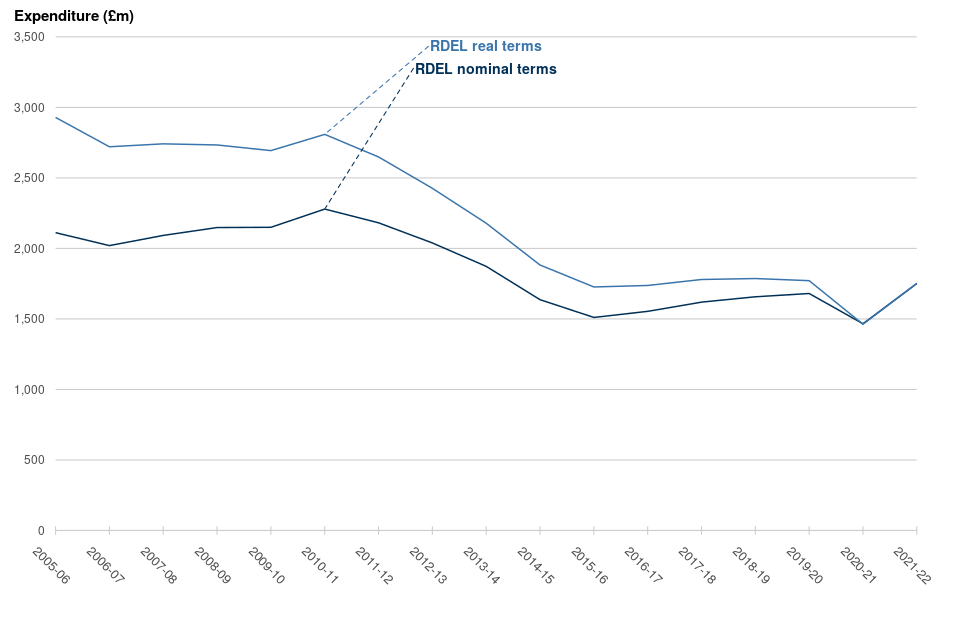
Criminal legal aid
| Web Tool | Help | Tables |
In the magistrates’ court the volume of completed work increased by 2% and associated expenditure increased by 8% when compared to the same period last year
Conversely at the police station the volume of work stayed the same but had an associated 11% increase in corresponding expenditure due to higher fees for police station advice introduced at the end of September 2022.
For more information on trends in criminal legal aid see here
Criminal legal aid can be categorised into Crime Lower and Crime Higher.
Crime Lower (covered in this report includes police station advice, magistrates’ court and prison law. Table 2.1 provides the Crime Lower workload whereas table 2.2 gives the Crime Lower expenditure.
Crime Higher (covered in this report covers work in the Crown and Higher Courts.
Figure 2: Crime overview, closed case volumes and expenditure for January to March 2023, and comparison with January to March 2022
(see interactive breakdown of crime)
| Crime Overview | Workload | Expenditure |
|---|---|---|
| Crime | 252,703 (2%⬈) | £220.0m (8%⬊) |
| Crime Lower | 211,714(0%⬌) | £67.4m(8%⬈) |
| Crown Court | 40,989(10%⬈) | £153.5m(8%⬈) |
| Crime Lower Category | Workload | Expenditure |
|---|---|---|
| Police Station Advice | 141,601(0%⬌) | £32.9m(11%⬈) |
| Magistrates’ courts | 66,049(2%⬈) | £29.7m(8%⬈) |
| Advice & assistance on appeals | 188(26%⬊) | £412k(11%⬊) |
| Prison Law | 3,854(9%⬊) | £4.4m(6%⬊) |
| Civil work associated with crime | 22(16%⬈) | £12.4k(49%⬈) |
| Crown Court Category | Workload | Expenditure |
|---|---|---|
| Solicitor fee scheme | 21,130(9%⬈) | £86.8m(1%⬈) |
| Advocate fee scheme | 19,855(10%⬈) | £65.4m(19%⬈) |
| High Cost crime cases | 4(300%⬈) | £1.4m(108%⬈) |
Although Crown Court work comprises a relatively small portion of criminal legal aid in terms of volume, it accounts for around two-thirds of all criminal legal aid expenditure. Conversely, advice relating to the police station makes up the largest portion of workload, but a much smaller proportion of expenditure.
Figure 3a: Workload in criminal legal aid, April to June 2011 to January to March 2023
(see interactive breakdown of crime trend and crime lower)
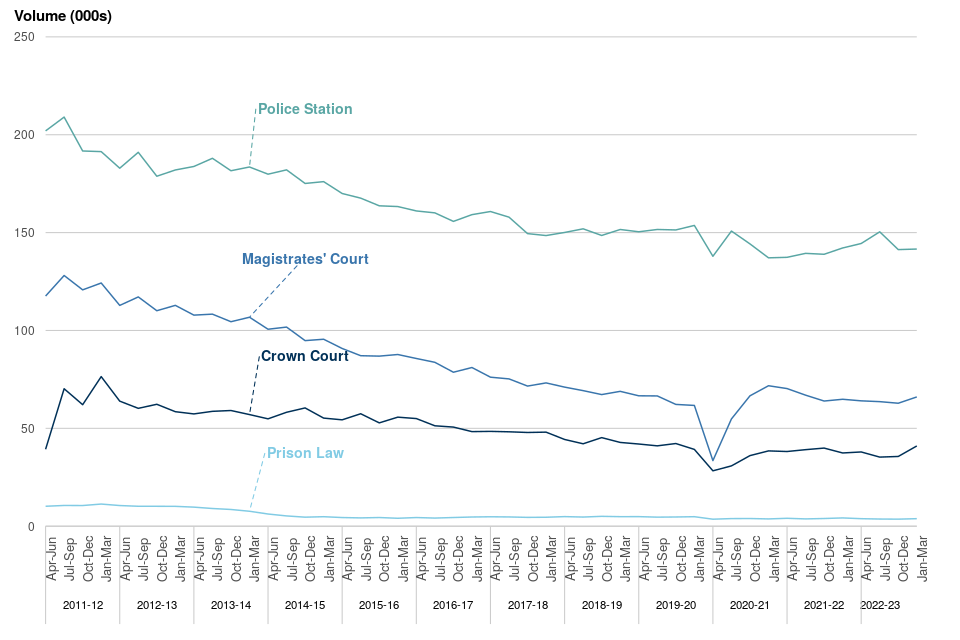
Figure 3b: Expenditure in criminal legal aid, April to June 2011 to January to March 2023
(see interactive breakdown of crime trend and crime higher)
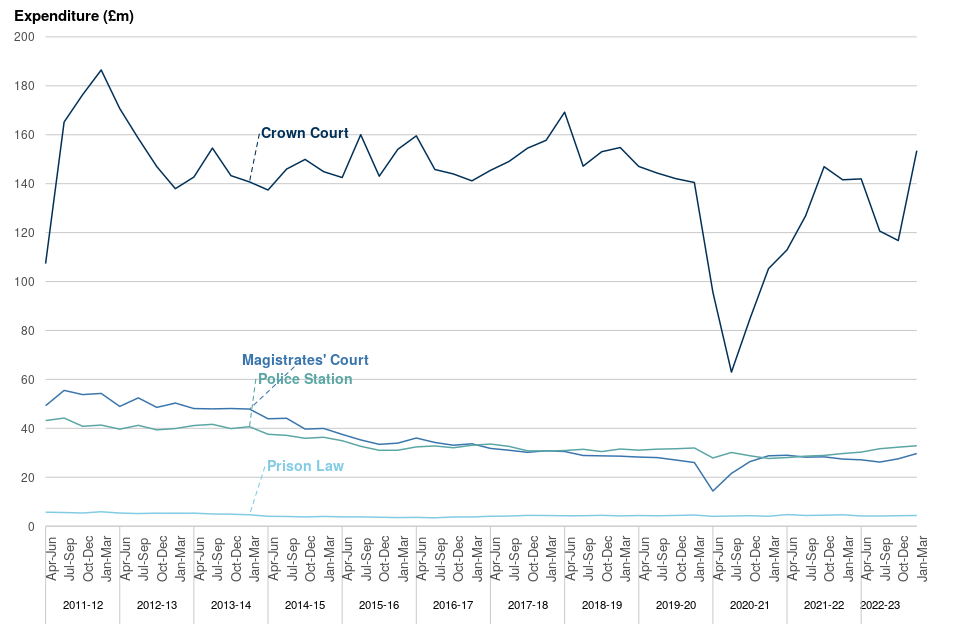
Note: Advice and assistance on appeals and civil work associated with crime are excluded from these figures.
Police station advice
This category made up two thirds of the Crime Lower workload between January and March 2023 but less than half of the expenditure. The workload in this period has remained steady compared to the previous year, with expenditure increasing by 11% (£3.2m). This is due to a 15% uplift in fees for police station advice introduced at the end of September 2022 as part of the criminal legal aid reforms. This reverses the general downward trend seen over the last few years with a decrease in police station advice workload since 2013-14.
The majority of the police station advice workload (89% in January and March 2023) consists of suspects receiving legal help with a solicitor in attendance at the police station, with the rest mainly consisting of legal advice over the telephone.
Applications and grants for representation in the criminal courts
While figures should be interpreted with caution as they may be revised in subsequent quarters as cases move into the Crown court, the number of orders granted for legally-aided representation in the Magistrates’ court increased by 8% this quarter when compared to the same quarter of the previous year. This reverses the downward trend of the last 3 years, which was largely driven by Summary Only cases.
Orders granted for legally-aided representation in the Crown court increased by 1% this quarter compared to last year. Within the legal aid figure, orders relating to either-way increased by 4% and indictable offences increased by 9% compared to a fall of 15% in committals for sentence. This fall in committals for sentence is driven by the extended sentencing powers for the magistrates’ courts with offences now remaining to be heard in the lower court. The proportion of Crown Court applications granted remains at almost 100%.
Magistrates’ court completed work
Legally-aided representation in the magistrates’ court comprised almost one-third of the workload and just under half of expenditure in Crime Lower between January and March 2023. The volume of completed work (covered in this report) increased by 2% this quarter when compared to the same period of the previous year. Expenditure also increased by 8% (£2.3m). These falls incorporate the accelerated Criminal legal aid reforms since October 2020 which cover payment for work on sending cases to the Crown Court. This new category shown in the tables accompanying this bulletin had 9,158 claims costing around £2.3m completed this quarter.
Crown Court completed work
Completed work volumes within the litigator (solicitor) fee scheme increased by 9% in January to March 2023 compared to the same period of the previous year, driven mainly by a 16% increase in trial claims. In the advocate fee scheme, completed claims increased by 10% compared to the same period last year. This recovery in workload is due to recovery of the fee schemes from the strike action in September 2022.
Figure 4a: Workload in the Crown Court, April to June 2011 to January to March 2023
(see interactive breakdown here)

In the litigator fee scheme, expenditure increased by 1% in January to March 2023 compared to the same period of the previous year. In the advocate fee scheme, the value of payments increased by 19% compared to the same period of the previous year. Figures for expenditure on work completed in the Crown Court should be interpreted with caution as they may be revised in subsequent quarters as claims are assessed further on appeal and further payments added to the value of some completed claims.
The Very High-Cost Case (VHCC) scheme covers those Crown Court cases which, if the case were to proceed to trial, would likely last more than 60 days. These cases can span several years and, while they may involve small numbers of defendants, the associated expenditure is high in comparison.
There were 4 defendants represented in the VHCC contracts that concluded in the January to March 2023 quarter. Expenditure on this work over the duration of the contracts (i.e. on the closed-case basis) was £1.4m. This compares with £8.7m of expenditure during the same period on all ongoing claims within the VHCC scheme suggesting that we have a large backlog of claims awaiting to finalise through the court system.
While workload comprises a tiny proportion of legal aid in the Crown Court overall, the VHCC scheme represents around 1% of the cost, although this is down from over 15% ten years ago.
Figure 4b: Expenditure in the Crown Court, April to June 2011 to January to March 2023
(see interactive breakdown here)

The large falls in completed expenditure are a consequence of the large fall in the number of jury trials completing in the Crown Court during covid, as all expenditure across the case will be in the final main bill. Figure 4c below, looking at the litigator fee scheme in isolation but equally applicable to both schemes, shows the impact of falling trials on expenditure – these types of cases are more likely to be impacted as they need more courtroom space and distancing measures and are likely to include witnesses and members of the public in the jury pool. Trial completed expenditure has been more adversely affected than guilty pleas and cracked trials, where a defendant changes their plea before the trial, with litigator fee expenditure much lower.
Figure 4c: Litigator Fee Scheme Crown Court expenditure by claim type, April to June 2011 to January to March 2023
(see interactive breakdown here)
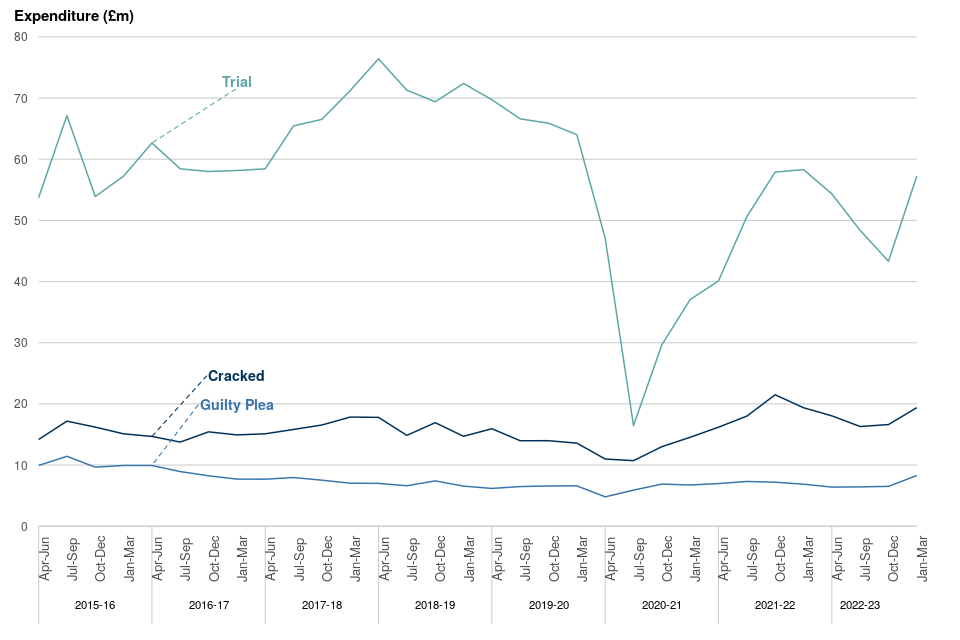
Prison Law
Workload this quarter decreased by 9% compared with the same period in the previous year, driven by free standing advice and assistance which fell by 16% when compared to January to March 2022.
Conversely, advocacy assistance at parole board hearings increased by 1% compared to last year and have increased by 3% since last quarter (see figure 5). Advocacy at parole board hearings currently makes up almost half of prison law workload, but a much larger proportion of costs (81%), even so expenditure on prison law overall decreased by 6% over this period due to a drop of 29% in free standing advice and assistance.
Since April to June 2020, the workload and expenditure for advocacy assistance at prison discipline hearings has remained low with a change in process for internal prisons hearings continuing since covid. Year-to-year comparisons show that workload decreased by 5% although expenditure increased by 11% this quarter compared to last year.
Figure 5a: Prison Law completed workload, April to June 2011 to January to March 2023
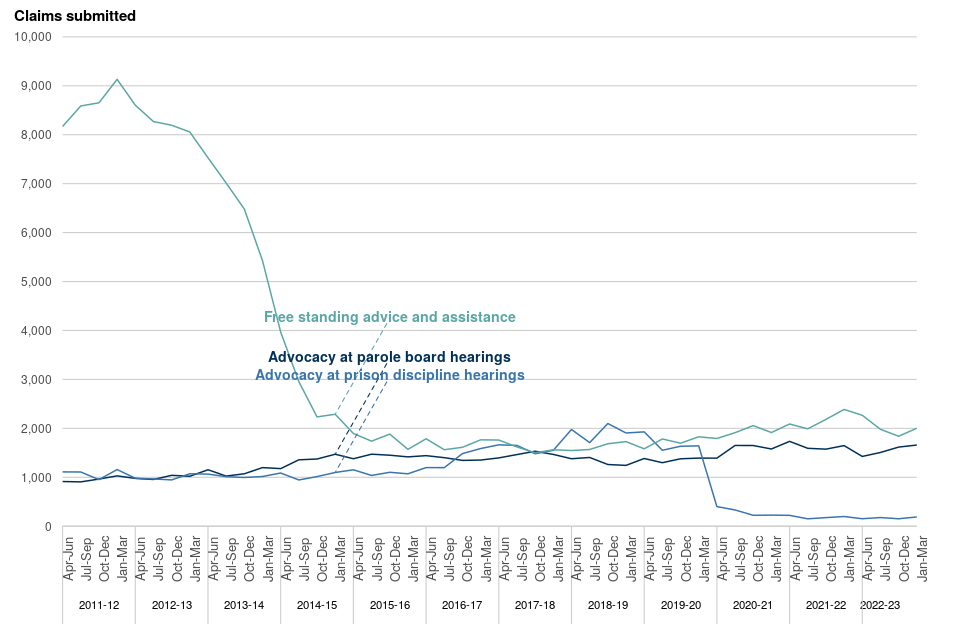
Figure 5b: Prison Law completed expenditure, April to June 2011 to January to March 2023
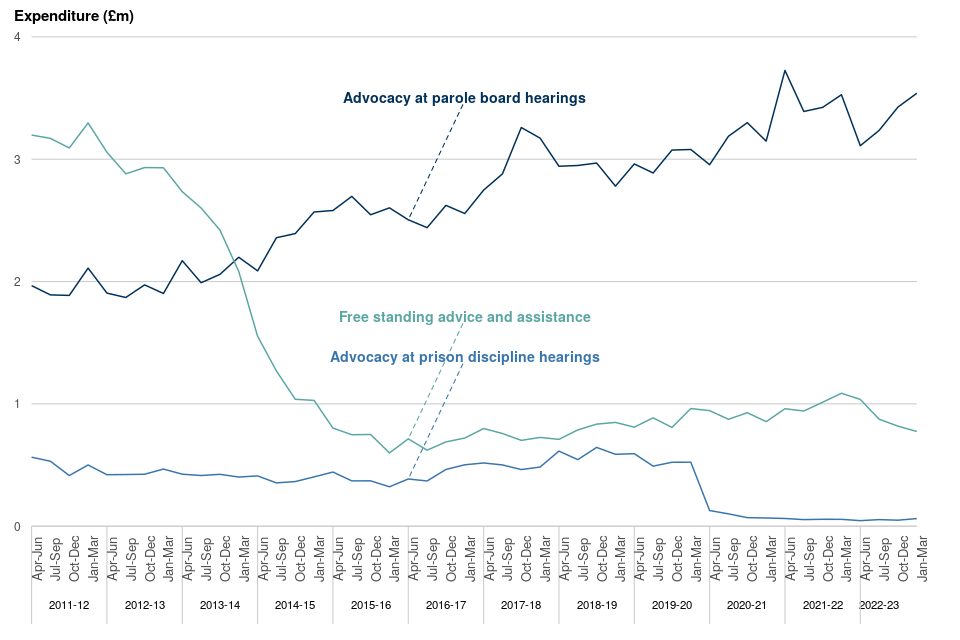
*New categories not shown: ‘advocacy assistance at sentence reviews’ and ‘advocacy assistance at Parole Board reconsideration hearings’
Central funds
In 2022-2023 the total expenditure for Central Funds was £55m. This is 31% higher than the previous year.
This area includes arrangements to meet costs in a variety of scenarios that are not covered by the main criminal legal aid schemes. Some aspects of these are administered by the Legal Aid Agency (LAA) and others by Her Majesty’s Courts and Tribunals Service. In 2022-2023 the total expenditure for Central Funds was £55m (Figure 6). This is 31% higher than the previous year and shows a levelling in the volume of court hearings during the financial year.
Figure 6: Central Funds expenditure, 2015-2016 to 2022-2023
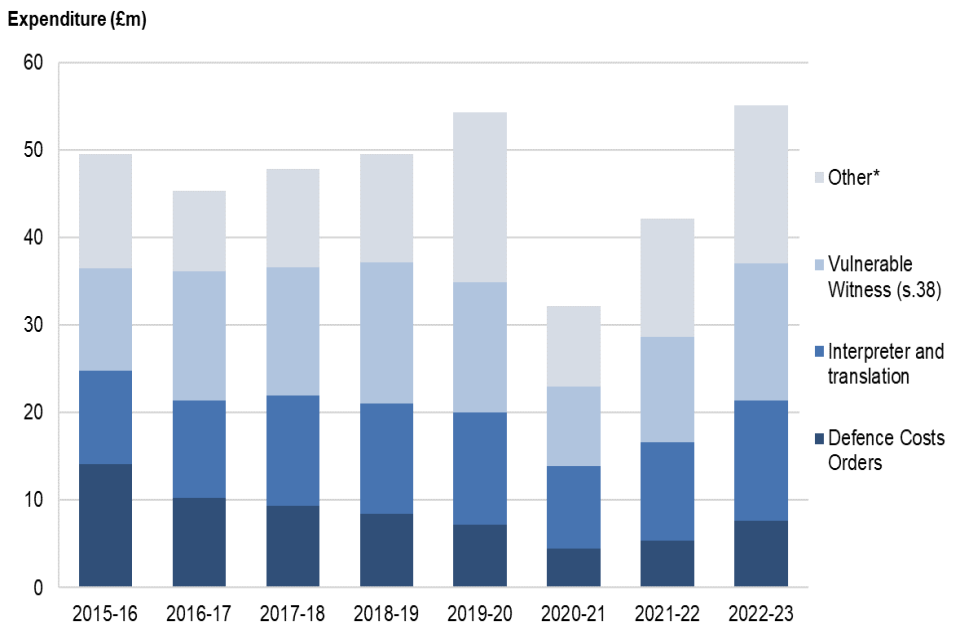
*Other includes intermediaries, private prosecutions and costs of attending magistrates’ court for witnesses, experts and defendants
A large category of expenditure (£7.6m in 2022-2023 relates to the reimbursement of defendants who have been acquitted after privately funding their defence lawyers. The process for assessing and authorising reimbursement of costs from central funds in this scenario is normally triggered when a judge grants a Defence Cost Order (DCO) for legal aid at magistrates’, Crown or higher courts.
Another sizeable area of Central Funds expenditure (£15.8m in 2022-2023) covers the costs of lawyers required where a defendant is unrepresented but where the court decides that the defendant must not themselves be allowed to cross-examine a vulnerable witness, with cases involving domestic violence being typical. This situation is covered by the terms of section 38 of the Youth Justice and Criminal Evidence Act 1999. The costs of interpreters and translators in court comprise another area of Central Funds expenditure (£13.7m in 2022-2023). The remainder of Central Funds expenditure goes to meet the costs of court intermediaries (£7.5m in 2022-2023) and successful private prosecutions (£9.2m in 2022-2023) and towards meeting some of the reasonable costs of attending magistrates’ court for witnesses, experts and defendants (£1.2m in 2022-2023).
Civil legal aid
| Web Tool | Help | Tables |
The number of certificates completed increased by 8%, and the associated expenditure increased by 15% over the same period. At a cost of around £228m in January to March 2023, total civil representation expenditure is the highest it has been since 2011-12.
This is due to the number of claims being paid outside of the fixed fee scheme increasing due to more time being taken during the court process.
For more info on trends in civil legal aid see here
Civil legal aid can be categorised by area of law into family and non-family. The category of family legal aid covers all work on both private and public family law and includes work associated with the Children Act, domestic abuse, financial provision and family mediation. Non-family legal aid encompasses all work related to immigration, mental health, housing and other non-family law.
Figure 7: Civil overview, closed case volumes and expenditure for January to March 2023, and comparison with January to March 2022
(see interactive breakdown of civil)
| Civil Overview | Workload | Expenditure |
|---|---|---|
| Civil | 69,190(8%⬈) | £254.3m(13%⬈) |
| Family | 30,493(5%⬈) | £211.2m(16%⬈) |
| Non-Family | 33,760 (13%⬈) | £41.8m(3%⬈) |
| Family Category | Workload | Expenditure |
|---|---|---|
| Family Public | 19,242(5%⬈) | £167.6m(13%⬈) |
| Family Private | 11,251(5%⬈) | £43.6m(30%⬈) |
| Mediation and MIAMs* | 4,937(1%⬊) | £1.5m(2%⬊) |
| Non-Family Category | Workload | Expenditure |
|---|---|---|
| Immigration | 12,872(24%⬈) | £12.2m(17%⬈) |
| Mental Health | 8,824(1%⬈) | £12.2m(0%⬌) |
| Housing | 8,172(17%⬈) | £5.5m(2%⬈) |
| Other Non-Family | 3,892(4%⬈) | £12.0m(7%⬊) |
*Not included in the Family total
Although workload for family and non-family law cases are similar, Non-family comprises a relatively small proportion, less than one-fifth, of civil legal aid expenditure. Public family legal aid makes up almost two thirds of family legal aid work and almost 80% of expenditure.
Legal help and controlled legal representation
In the last quarter, there was a 6% increase in legal help new matter starts compared to the same period of 2022. The volume of completed claims increased by 10% and expenditure increased by 1% in January to March 2023 compared to the same period in 2022 (figure 8).
The implementation of the LASPO Act in April 2013 resulted in large reductions in legal help workload, with the decline in the overall trend being further exacerbated by the effects of covid-19, workload now sits at less than one-quarter of pre-LASPO levels.
Figure 8a: Completed workload in legal help and controlled legal representation, April to June 2011 to January to March 2023
(see interactive breakdown of legal help)
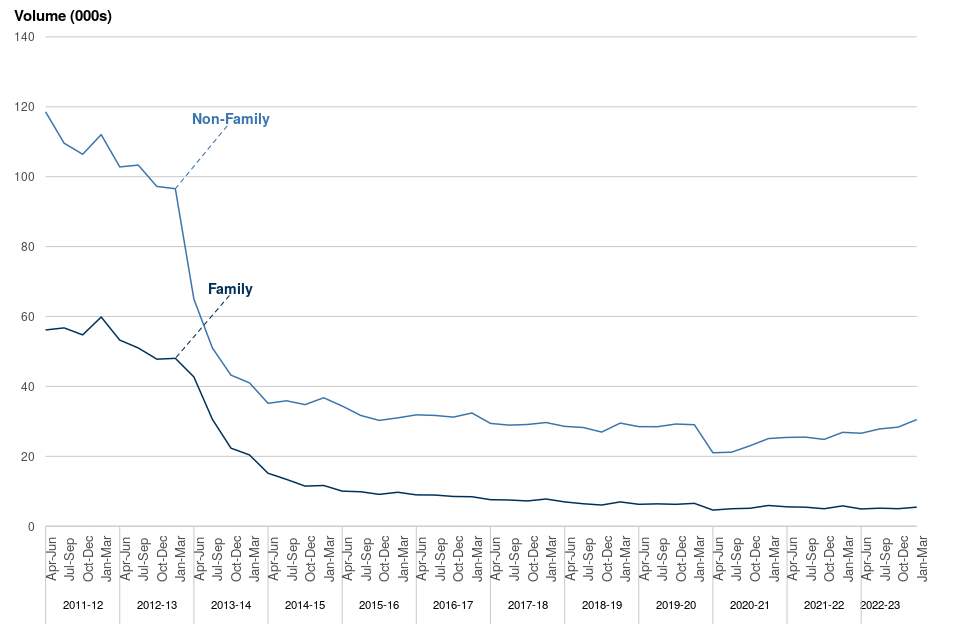
Figure 8b: Completed workload expenditure in legal help and controlled legal representation, April to June 2011 to January to March 2023
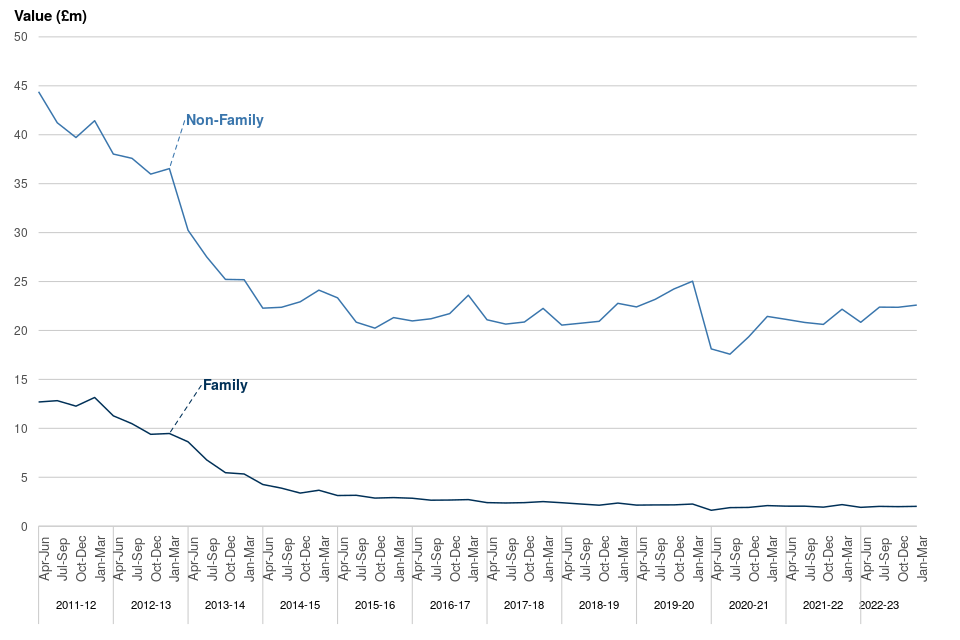
Family legal help
There was a steep decline in family legal help immediately following the implementation of LASPO Act in April 2013, with a more gradual decline over the last 6 years.
From 1 September 2021, callers to the Civil Legal Advice (CLA) helpline with family issues are no longer referred to specialist telephone advice. In January to March 2023 family legal help starts decreased by 3% compared to the same quarter last year. Completed claims also decreased by 6% and expenditure decreased by 8%.
Family mediation involves an independent and impartial professionally-accredited mediator discussing problems with a divorcing or separating couple. A Mediation Information and Assessment Meeting (MIAMs) is an initial meeting between one or both parties and a mediator to see if family mediation could be used to reach agreement without using the courts. MIAMs, family mediation starts, and outcomes decreased significantly following the covid-19 restrictions in March 2020. Since, volumes and expenditure had rapidly increased to levels temporarily exceeding pre-covid figures. MIAMs remained level in the last quarter compared to the previous year although they currently stand at just over a third of pre-LASPO levels. Family mediation starts increased by 14% and total outcomes decreased by 2%, of which 56% were successful agreements, and are now sitting at around half of pre-LASPO levels.
Figure 9: Family mediation assessments, starts and agreements, April to June 2011 to January to March 2023
(see interactive breakdown for mediation)
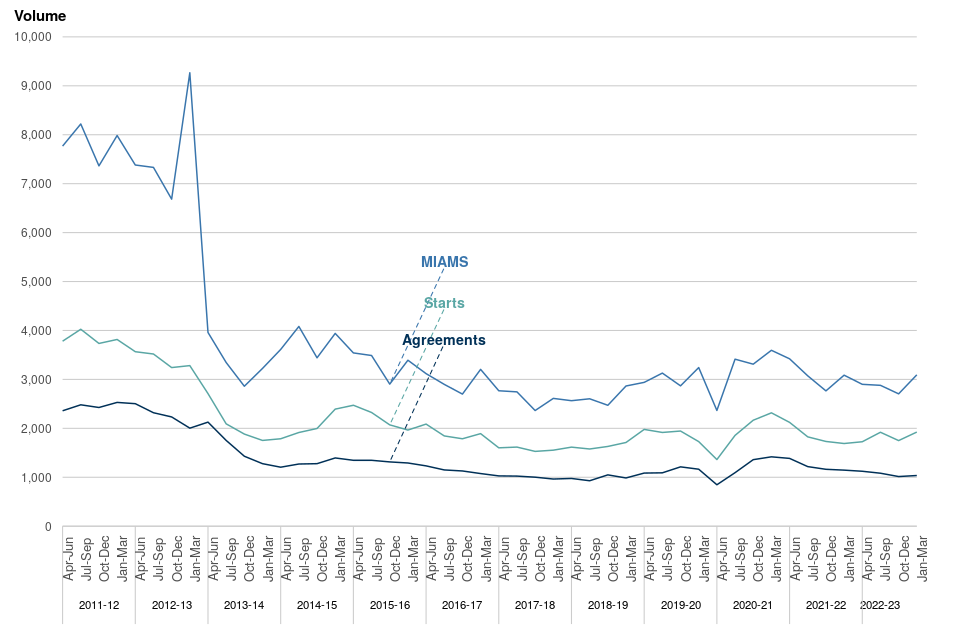
Non-family legal help and controlled legal representation
Controlled legal representation relates to representation at tribunal, but unlike civil representation, the decision on whether to grant legal aid is delegated to providers.
Legal help and controlled legal representation make up around 95% of both immigration and mental health legal aid cases.
The LASPO Act 2012 made changes to the scope of legal aid for immigration law, but some areas remained in scope. Workload that remains in the immigration category consists largely of asylum-related work. Having fallen by over 45% in April to June 2020, new matter starts in immigration increased by 15% in January to March 2023 compared to the same quarter of the previous year. Completed claims in immigration increased by 25% in the last quarter compared to the previous year and expenditure increased by 10%.
Within mental health, most funding is spent on providing assistance to sectioned clients appealing the terms of their detention before a mental health tribunal. Mental health new matter starts decreased by 6% when comparing the latest quarter to the previous year. Completed claim volumes remain steady and associated expenditure decreased by only 1% over the same period.
Over 80% of legal aid housing work volume is made up of legal help. The volume of legally-aided housing work halved between July to September 2012 and July to September 2013. The trend then fluctuated for around 18 months but since 2014 it has been falling. Housing legal aid was particularly affected by covid-19 with starts and completed claims nearly halving again between January to March 2020 and April to June 2020. In January to March 2023 there was a 16% increase in housing work starts compared to the same quarter the previous year. There were also increases in completed claims (15%) and conversely a decrease in expenditure (8%).
Civil representation
The number of civil representation certificates granted in the last quarter decreased by 2% compared to the same period of the previous year. The number of certificates completed increased by 8%, and the associated expenditure increased by 15% over the same period.
This is due to the number of claims being paid outside of the fixed fee scheme increasing due to more time being taken during the court process. At a cost of around £228m in January to March 2023, total civil representation expenditure is the highest it has been since 2011-12.
Figure 10a: Completed workload in civil representation, April to June 2011 to January to March 2023
(see interactive breakdown here)
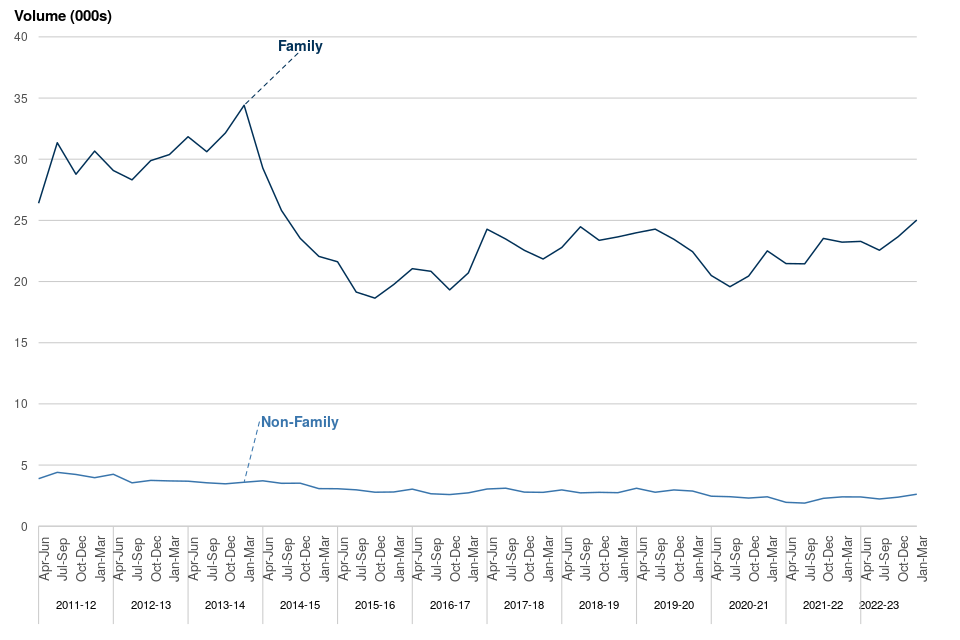
Figure 10b: Completed workload expenditure in civil representation, April to June 2011 to January to March 2023
(see interactive breakdown here)
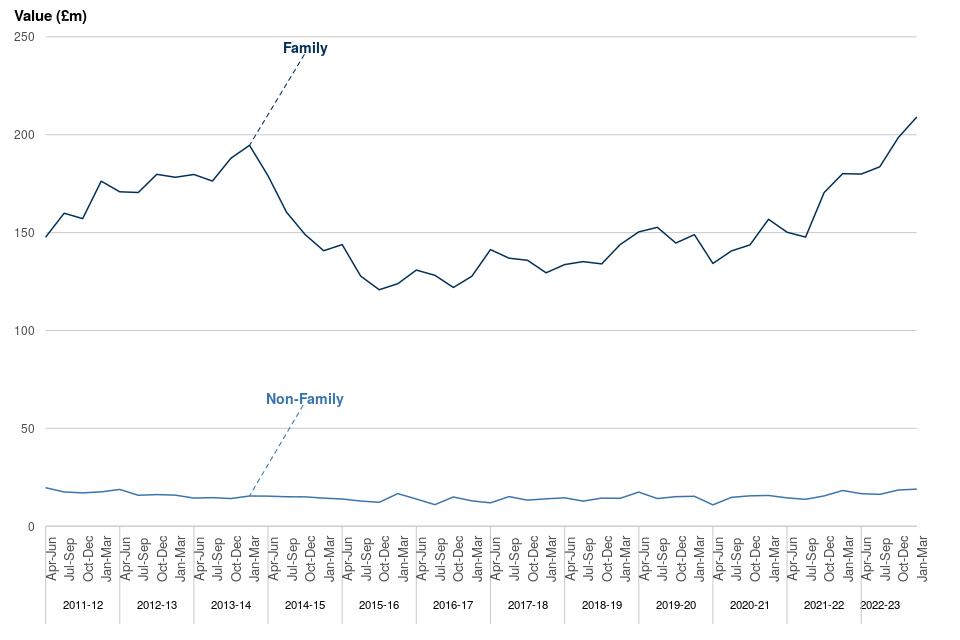
Non-Family Civil Representation
Non-family certificates completed make up 11% of the total civil representation workload and 8% of the expenditure. There are only a small number of immigration and mental health cases in civil representation as most work in these areas consists of controlled legal representation. A large proportion of certificates completed in this category are for housing work. There has been a gradual decline in housing certificates completed and expenditure since 2014. In the latest period, completed certificates increased by 29% compared to the same period of the previous year.
Family civil representation
While civil representation for public family law remains available, the LASPO Act removed legal aid for most private family law including issues such as contact or divorce. However, legal aid remains available for such cases where there is a risk of domestic violence or child abuse. Certificates granted for family work decreased by 4% in January to March 2023 compared to the previous year. Certificates completed increased by 8% and associated expenditure has increased by 16% compared to the same quarter the previous year. The volume and expenditure for closed case domestic violence civil representation increased substantially following the initial impacts of covid-19. In January to March 2023, certificates completed for domestic violence have remained the same compared to the same period of the previous year.
In January to March 2023, applications for civil representation supported by evidence of domestic violence or child abuse decreased by 2% compared to the same period of the previous year. The number of certificates granted via the domestic violence and child abuse gateway increased by 4% over the same period. The proportion of applications granted remained steady at around 70% from the inception of this type of application until the end of 2015, before increasing to around 80%. The provisional figure for the latest quarter is 85%.
Figure 11: Applications received and total certificates granted via the domestic violence and child abuse gateway, April to June 2013 to January to March 2023
(see interactive breakdown here)
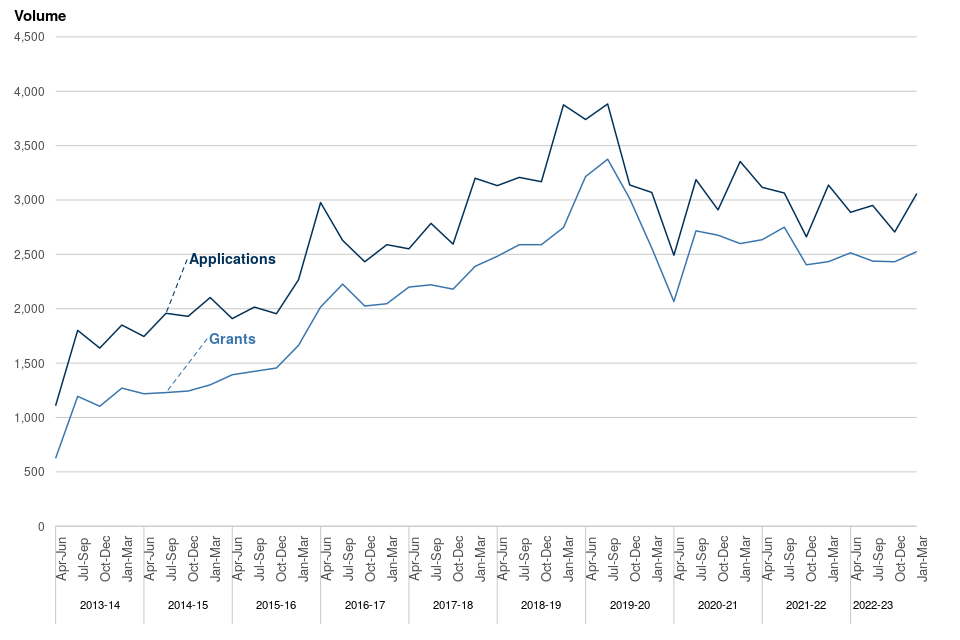
Judicial reviews
Of all civil representation applications granted, 665 in the last quarter related to a judicial review. The number granted in January to March 2023 increased by 11% compared with the same quarter in 2022. Over a half of judicial reviews were for public law. Judicial review data is available in the detailed csv accompanying this bulletin.
Exceptional Case Funding (ECF)
The Exceptional Case Funding (ECF) scheme was introduced as part of LASPO. An ECF application for civil legal services is made where a case falls outside the scope of civil legal aid but the client or conducting solicitor believes failure to provide funding would be a breach of the Human Rights Act 1998
There were 808 applications for ECF received from January to March 2023. This is a 12% decrease from the same quarter last year. 747 (92%) of these were new applications.
Of the 808 ECF applications received between January and March 2023, 97% (783) had been determined by the LAA as of 01 March 2023. 75% (584) of these were granted, 14% (113) were refused and 9% (68) rejected (see figure 12).
Figure 12: Volume of ECF applications received, April to June 2014 to January to March 2023
(see interactive breakdown here)
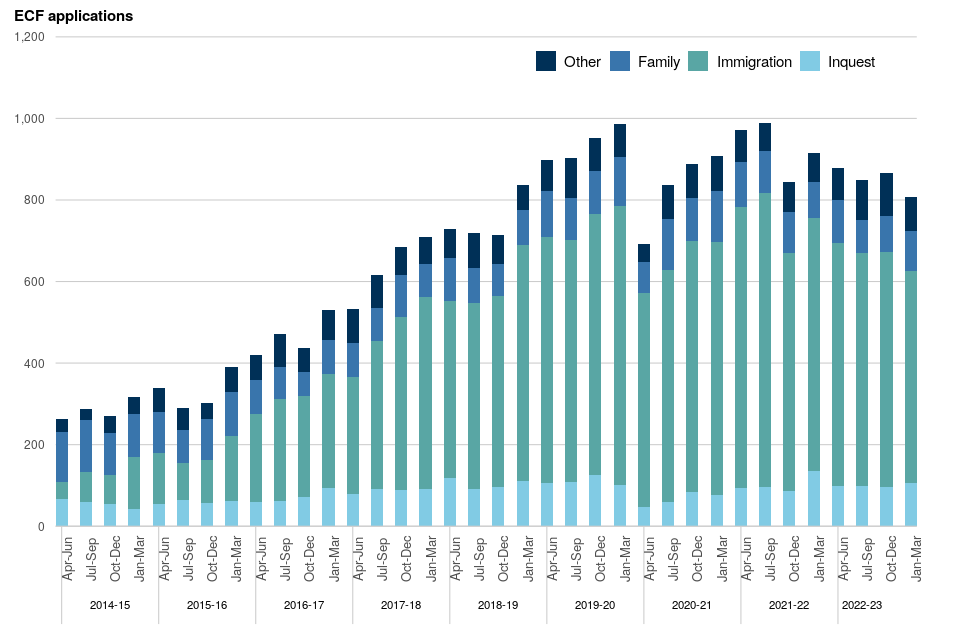
Among the ECF applications received between January and March 2023, immigration (64%), inquest (13%), and family (12%) remained the most requested categories of law. The increase in ECF applications over the last four years is driven by an increase in immigration applications.
Figure 13: Volume of ECF determinations by outcome, April to June 2013 to January to March 2023
(see interactive breakdown here)
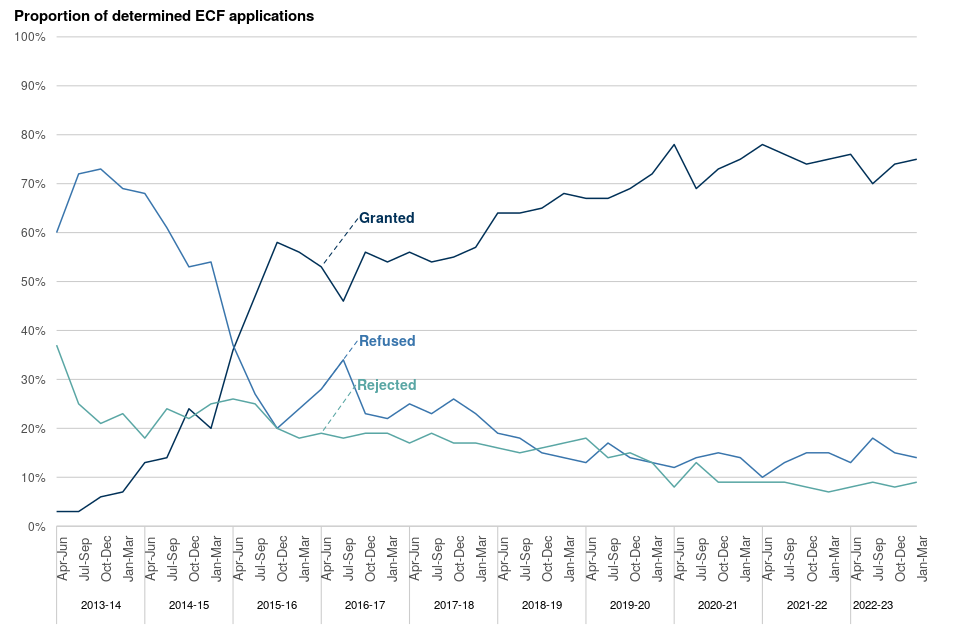
Client Diversity
In general, the proportions of legal aid work by sex, disability status, ethnicity and age band of the client in 2022-23 are consistent with 2021-22.
A diversity data file and dashboard is published alongside this year-end bulletin. This breaks down legal aid work by the sex, disability status, ethnicity and age band of the client and, for criminal legal aid, the applicant. In this chapter, this data is compared with the national breakdown from the 2021 census data from the Office for National Statistics. More detail on disclosure control, methodology and data quality can be found in the User Guide to legal aid statistics. In general, the diversity of legal aid clients compared to 2021-22 is unchanged. This stability in proportions over time can be seen in Table 11.1.
Sex
The profile of criminal legal aid clients in 2022-23 differs from the population average with a greater proportion of males in the former (Figure 14). This reflects the picture across the criminal justice system as a whole and is consistent over time. However, the proportion of females varies with the type of work being claimed for. In 2022-23, 14% of magistrates’ court representation work and 16% of police station advice involved females whereas, only 3% of prison law work was for females.
Figure 14: Proportion of legal aid clients by sex, 2022-23
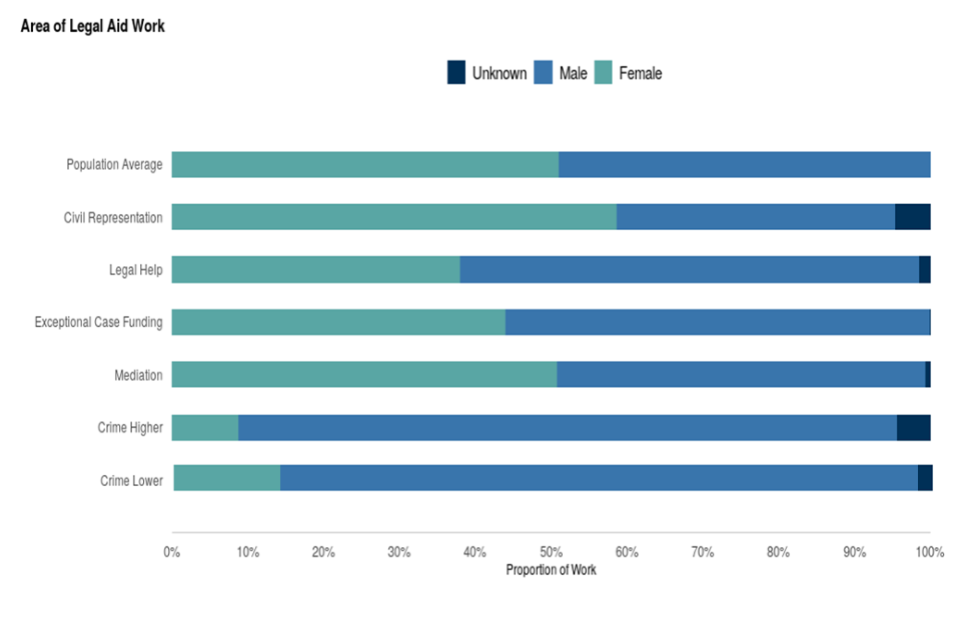
The profile of civil legal aid clients in 2022-23 more closely matches the general population, with some variation by scheme. There is a greater proportion of female clients in Civil Representation (59%), and a slightly smaller proportion in Mediation (51%), ECF (44%) and Legal Help (38%). The proportion of female legal help clients decreased by 14 percentage points since 2013-14, driven mainly by immigration where the proportion of females has decreased from around a third to around a fifth. Within the housing possession court duty scheme, clients broadly match the general population. Overall, the proportions of male and female civil representation clients have remained level over the last few years. Within civil representation, the proportion of males in the domestic violence category has fallen from 13% in 2013-14 to 5% in 2022-23.
Disability
It is difficult to draw firm conclusions for most categories of legal aid regarding this characteristic because of the relatively high proportion of unknowns. Crime Higher has the lowest proportion of unknowns, although no detail about the type of disability is recorded (as with Crime Lower). A higher proportion of legally aided Crown Court defendants have a disability (30%) than the population average (18%).
Figures show that a higher proportion of legal help clients have disabilities (27%) than the general population (18%), although this difference is likely to be larger due to the high proportion of unknowns. This may be partly because mental health controlled legal representation work is included within legal help. In 2022-23, just less than two thirds of the legal help closed case mental health work claims had the client recorded as having a mental health condition. Mediation while having a comparatively low proportion of unknowns has a lower proportion of clients who are disabled (7%) than the population average.
Ethnicity
It is difficult to draw firm conclusions from some of the ethnicity data because of the high proportion for which ethnicity is unknown in most areas. Nevertheless, the proportion of legal help and ECF clients reporting as Black/Asian/Minority Ethnic is much larger than in the general population (Figure 15). This is likely to reflect the fact that controlled legal representation (CLR) for immigration is included within legal help and the majority of ECF grants are for immigration work.
Figure 15: Proportion of legal help and ECF clients by broad ethnic category, 2022-23
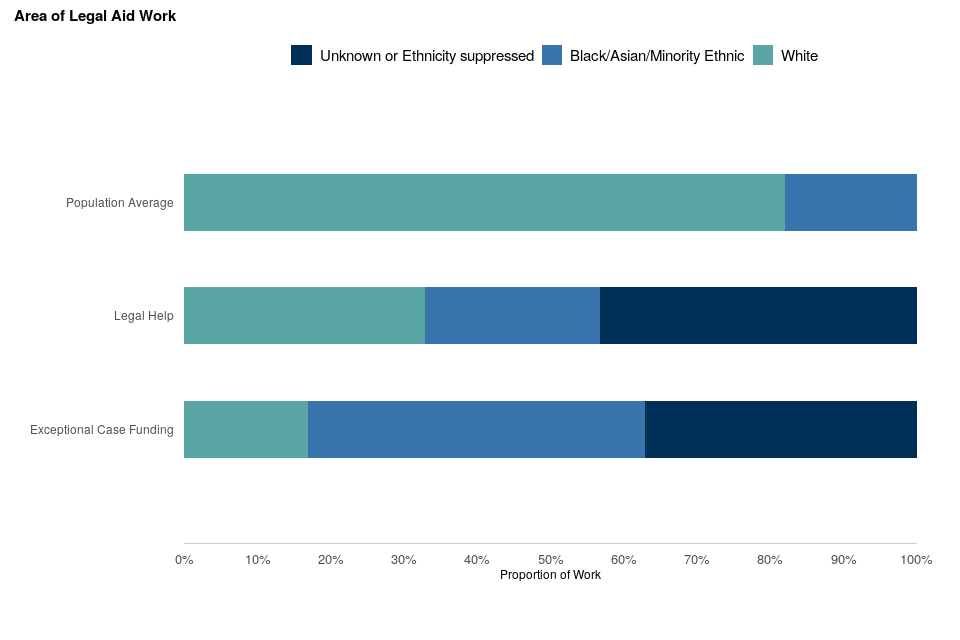
The profile of criminal legal aid clients in 2022-23 more closely matches the general population, although the proportion of Black/Asian/Minority Ethnic clients is likely to be larger due to the high proportion of unknowns.
Age
Generally, the age profile of legal aid clients is much less evenly spread than the population average, with a higher proportion of working age clients and a smaller proportion of over 55s. A much greater proportion of criminal legal aid clients are from young adult age groups (aged 25-34 and 35-44) than in the general population.
Civil representation has the greatest relative proportion of clients under the age of 18, who make up less than one tenth of work completed in 2022-23. Within this, other public law children act proceedings and special children act proceedings both had high proportions of clients under 18; 67% and 47% respectively in 2022-23. The overall age profile of clients in 2022-23 is similar to previous years, although there has been an increase in the proportion of those under 18 in legal help, increasing by 3% in 2013-14 to 10% in 2022-23 and civil representation, increasing by 24% in 2013-14 to 33% in 2022-23.
Legal aid providers
| Web Tool | Help | Tables |
Over the last 5 years there has been a fall in the number of provider offices completing legal aid work, however there has been an increase in provider offices completing legal aid work in the most recent year.
Over the past year, the number of providers that have received payment for civil work decreased by 2% and increased by 6% for criminal work. Figures for providers starting civil work during the period decreased by 6% and providers starting criminal work was up by 9%.
Legal aid services in England and Wales are delivered through solicitor firms, Not-for-profit organisations, telephone operators and barristers, most of whom are contracted by the LAA to do legal aid work. This chapter presents the number of providers who have completed work and received associated payments from the LAA in any given quarter or financial year.
A set of provider data files and provider dashboard is published alongside this year-end bulletin. A provider may consist of a large firm with several offices around the country or a single office location at which one or more individuals are based. For more information on data sources, quality and usage please see the User guide to legal aid statistics. The timing with which a completed piece of work and the total payment, or expenditure, associated with it are reported are based on the point at which the main final payment for that piece of work was authorised by the LAA, not the timing of cash transactions.
Figures for a given period may include the value of work conducted in earlier periods and the expenditure represents the total legal aid fee payments for each item of completed work. These figures are not equivalent to providers’ profits, earnings or take-home pay. Figures are based on the provider office location and not the location of the client. A provider may serve clients from other geographic areas as well as that in which the office is located. As this data reflects only the location of the provider office it cannot be used as a reliable indicator of the distribution of the clients or benefits of legal aid, or to infer a precise picture of coverage of legal aid services.
Volume of providers completing and starting work
Across civil legal aid, the number of provider offices completing work has fallen by 14% over the last 5 years and a 2% fall in offices completing work the last year. There was a more gradual downward trend for criminal work, although with the last year there is now an 8% decrease in the number of provider offices over the last 5 years, but a 6% increase over the last year. Over the last five years, there has been a decrease in the number of providers starting civil work also, a drop in providers starting criminal work during the period. In the last financial year, the number of providers starting civil work decreased by 6% compared to the previous year and providers starting criminal work was up by 9%.
Figure 16a: Number of provider offices completing criminal legal aid work, 2013-14 to 2022-23

Figure 16b: Number of provider offices completing civil legal aid work, 2013-14 to 2022-23

Legal Aid Provider Contracts
The number of providers contracted to deliver legal aid services has fallen in recent years. In June 2023, there were 2,036 such providers across both crime and civil areas of law, down from 2,281 four years earlier in June 2019.
This equates to a reduction of 11%. Similarly, the number of provider offices contracted to deliver legal aid services has also fallen over this period, from 3,643 in June 2019 to 3,218 in June 2023, a reduction of 12%. Of these providers, the number contracted to deliver civil legal aid has fallen from 1,551 in June 2019 to 1,274 in June 2023. Likewise, the number of provider offices contracted to deliver civil legal aid has fallen from 2,521 in June 2019 to 2,053 in June 2023.
Meanwhile, the number of providers contracted to deliver criminal legal aid has fallen from 1,186 in June 2019 to 1,102 in June 2023. The number of provider offices has also reduced from 1,788 to 1,655 over the same period.
Like the previous chapter, these statistics relate to the number of legal aid providers in England and Wales. However, instead of reporting the number of providers starting and completing cases, this chapter instead shows the number of legal aid providers and offices that hold either a crime and/or civil contract in each month. As some providers bill their work in months when they do not hold a contract, these numbers are slightly lower than those presented in the previous chapter. These statistics do not include non-Contracted providers who may be operating under an Individual Case Contract. The number of legal aid providers and offices is accurate as at the start of each month.
These statistics are used by the LAA as management information to monitor the capacity of legal aid services over time, in different areas of law and different regions of England Wales. They are nonetheless a proxy measure of capacity only, since they do not indicate the number of practitioners at a given time. The underlying anonymised data files and an interactive data dashboard are published quarterly alongside this bulletin. This tool additionally shows the number of members and offices for each police station duty solicitor scheme.
It should be noted that some monthly changes in the number of providers contracted to deliver legal aid services (e.g. in October 2022) are driven by the commencement of new contracts, where typically we see a peak in provider numbers which then reduce during the lifetime of the Contract. Figures may change for previous months to reflect changes in contract holders that are processed in retrospect.
For the number of civil legal aid providers reported in Table 9.7, definitions of each category of law under the Standard civil contract 2018 can be found on the gov.uk website
Geographical figures are based on the provider office location and not the location of the client. A provider may serve clients from other geographic areas as well as that in which the office is located. As this data reflects only the location of the provider office it cannot be used as a reliable indicator of the distribution of the clients or benefits of legal aid, or to infer a precise picture of coverage of legal aid services.
Experimental Statistics: Criminal Legal Aid data share
As part of the Independent review into criminal legal aid towards obtaining a complete picture of the legal services provider base (advocacy and litigation) for the publicly-funded criminal justice system in England and Wales, this section discusses the analytical findings from the Data sharing agreements between The Law Society, the Bar Council, the Legal Aid Agency, the Crown Prosecution Service and the Ministry of Justice. The commentary on the analysis is built upon the Summary Information on Publicly Funded Criminal Legal Services
This chapter provides an analysis of the publicly-funded criminal legal system, detailing insights into the characteristics of law firms, their solicitors and barristers that received publicly-funded legal aid case payments. The analysis covers financial year 2014-15 to 2019-20 with further data released in September 2023.
Firms that were identified, through the data matching, as receiving criminal legal aid payments during the financial years covered are referred to as criminal legal aid firms. The criminal legal aid fee income shown in the following tables includes disbursements and VAT when applicable for the matched criminal legal aid firms.
Solicitor Firms
Number of solicitor firms reduced by 18% from 1,455 in 2014-15 to 1,199 in 2019-20. For more detailed breakdowns and information on criminal legal aid firms see the interactive dashboard
Figure 17: Number of Criminal legal aid Solicitors Firms by number of partners
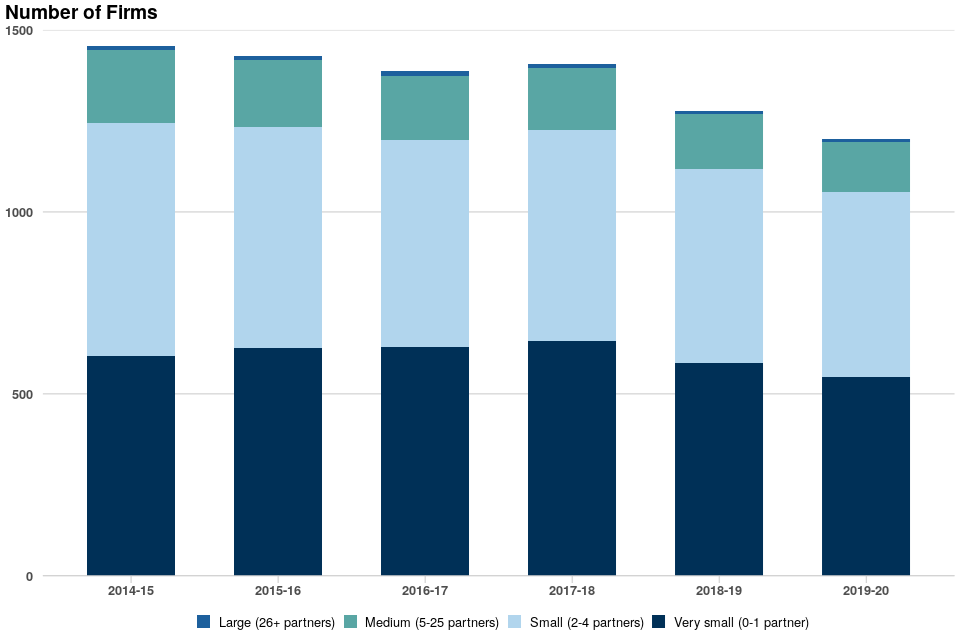
Over the years there has been a gradual reduction in the number of criminal legal aid firms with a fall seen over the financial years considered in this report. Approximately 45% of criminal legal aid firms had criminal legal aid fee income below £250k, constituting 10% of the total criminal legal aid fee income. In 2019-20, 34% of criminal legal aid firms with criminal legal aid fee income surpassing £500k accounted for 73% of the total criminal legal aid fee income, a decline of around 3% compared to the previous year.
Between 2014-15 and 2019-20, there was an approximate 3% increase in the number of ‘Very small’ criminal legal aid firms (0 – 1 partner), resulting in a corresponding 9% increase in the share of the total fee income. Concurrently, criminal legal aid firms with 5 or more partners represented 15% of all firms during this time frame and received approximately 15% of the total fee income.
In 2014-2015, 50% of criminal legal aid firms had a turnover below £600k, receiving about 54% of the total criminal legal aid fee income. By 2019-20, these proportions increased slightly, with 55% of solicitor firms having reported a turnover below £600k; these accounted for 57% of the total fee income. Across the geographical regions the proportion of solicitor firms head offices varies from 4% in Wales to about maximum of 20% in London, in 2014-15. This proportion remained relatively stable over the years studied.
In 2017-18, there was a 128% increase in the number of firms joining the criminal legal aid market, with 107 firms entering the market compared to 47 firms in the previous year. This increase was driven by the introduction of new legal aid contracts in 2017. The data shows that there was a significant surge in firm participation at the beginning of the new contract.
It is also worth noting that about half of all the firms leaving the criminal legal aid market reported a turnover below £600k in the year preceding their exit. This suggests that smaller firms may have been disproportionately affected by the changes to the legal aid contracts.
Solicitors and Trainees
Overall decline of 27% in the number of criminal legal aid solicitors, from 13,724 (2014-15) to 10,047 (2019-20) For more detailed breakdowns and information on criminal legal aid solicitor firms see the interactive dashboard
Figure 18: Trends in Criminal Legal Aid Solicitors volumes

The decrease in the number of criminal legal aid firms between 2014-15 to 2019-20 is also seen in the decrease in the number of solicitors. There has been a gradual shift towards a more balanced gender representation within the solicitors, the data shows that the proportion of females increased from 46% in 2014-15 to 52% in 2019-20, with a related decline in the proportion of males to 47% in 2019-20.
Figure 19: Proportion of Criminal legal aid solicitors split by gender
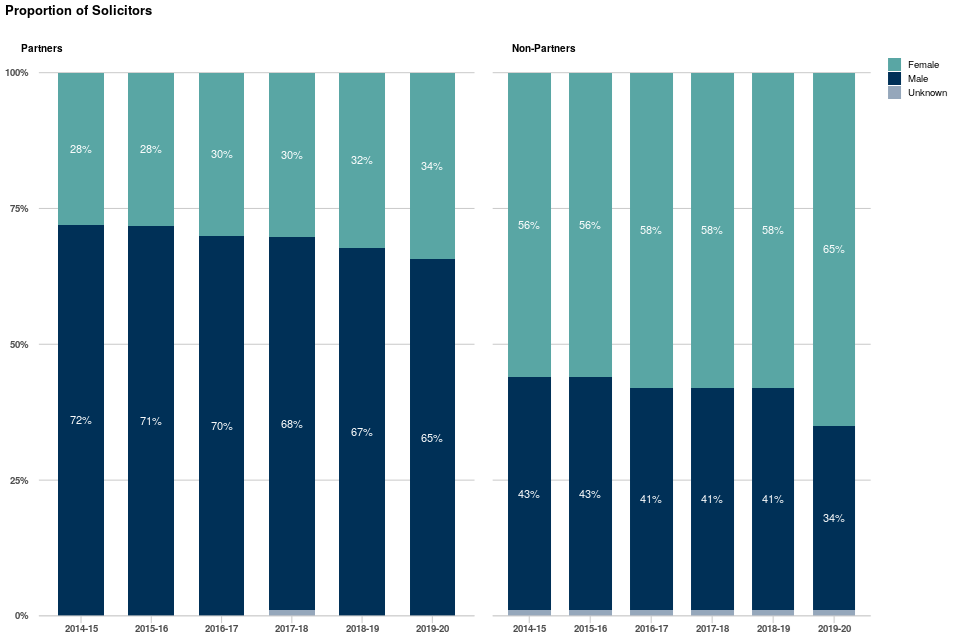
In 2018-19, 32% (3,372) of solicitors registered as partners in criminal legal aid firms. This marked the lowest point in a declining trend from 34% (4,645) in 2014-15. However, there was an improvement in 2019-20, with the proportion of partners rising to 41% (4,162). Among these partners, 34% (1,430) were females, which showed a marked increase from 28% (1,295) in 2014-15, which yielded a consequential steady decline in the proportion of male partners during the same period. Furthermore, in 2019-20, females accounted for approximately two-thirds of all non-partner criminal legal aid firm solicitors.
Figure 20: Proportion of Trainees in criminal legal aid solicitors firms
For more information on solicitor firms trainees see the interactive dashboard
| Year | 2014-15 | 2015-16 | 2016-17 | 2017-18 | 2018-19 | 2019-20 |
|---|---|---|---|---|---|---|
| Trainees in firms | 590 | 680 | 719 | 701 | 630 | 858 |
| % trained in firms | 11% | 12% | 13% | 12% | 10% | 8% |
| Firms with trainees | 252 | 264 | 262 | 268 | 272 | 280 |
| %Firms with trainees | 17% | 18% | 19% | 19% | 21% | 23% |
The proportion of trainees trained in solicitor firms increased from 11% in 2014-15 to 13% in 2016-17, and then decreases slightly to 8% in 2019-20, despite a relative increase in the number of trainees. Similarly, the proportion of criminal legal aid firms with trainees shows a consistent upward trend, with 23% of criminal legal aid firms involved in traineeship.
During the same period, the majority (60%) of solicitors firms with trainees had only one trainee, while the percentage of firms with two trainees ranged between 15% and 22% throughout the timeframe. In terms of gender distribution, approximately 65% of trainees in criminal legal aid firms were female between 2014-15 and 2018-19, with a negligible proportion of unknown/prefer not to say. However, due to changes in information collection methods, this proportion increased to around 99% in 2019-20. Based on the year the individual started their training, around 45% of trainees were trained in small-sized firms (2-4 partners), while 35% received training in medium-sized firms (5-25 partners).
Duty Solicitors
Figure 21: Trends in Criminal legal aid Duty solicitors volumes
For more detailed breakdowns and information on criminal legal aid firms see the interactive dashboard
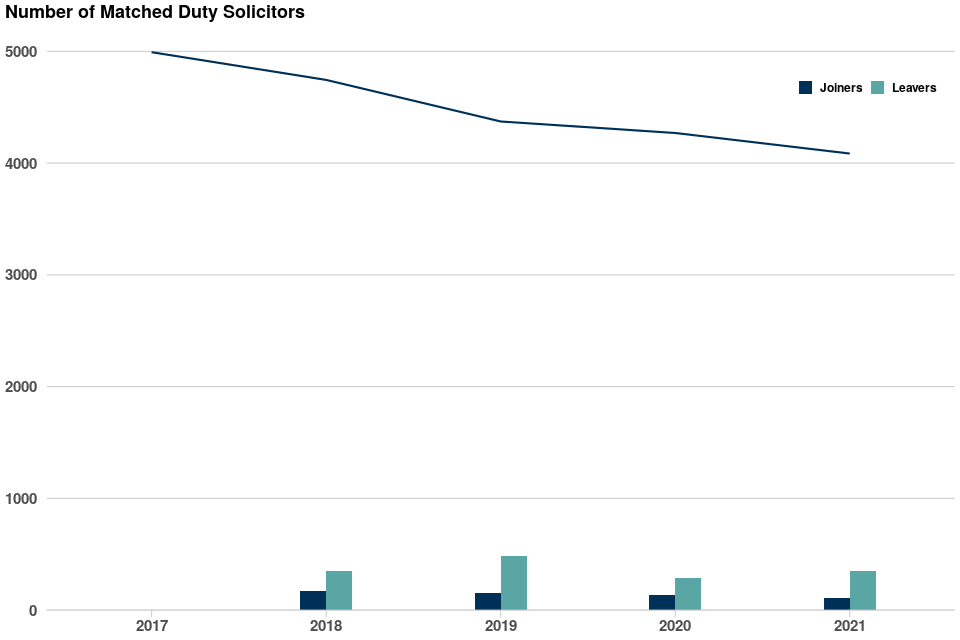
This section discusses characteristics of duty solicitors who have been successfully matched with corresponding Law Society individual characteristics for the year considered. Over the years, around 64% of duty solicitors were male while 35% were female. With a third of the duty solicitors between the age of 45 – 54 years, the proportion of duty solicitors aged 65 years and above increased slightly from 6% in 2017 to 8% in 2020. The average age of duty solicitors has increased gradually from 49 in 2017 to 51 in 2020. The proportion of partnered solicitors on the duty solicitors rota increased from 36% in 2018 to 47% in 2020.
The proportion of male solicitors who joined/re-joined the duty solicitor rota increased from 48% in 2018 to 53% in 2020, while the proportion of female solicitors who joined the rota decreased from 51% in 2018 to 46% in 2020. Additionally, leavers of the duty solicitor rota were around 60% male between 2018 and 2020.
Self-employed criminal barristers
Figure 22: Trends in Criminal legal aid Barristers volumes
For more detailed breakdowns and information on barristers see the interactive dashboard
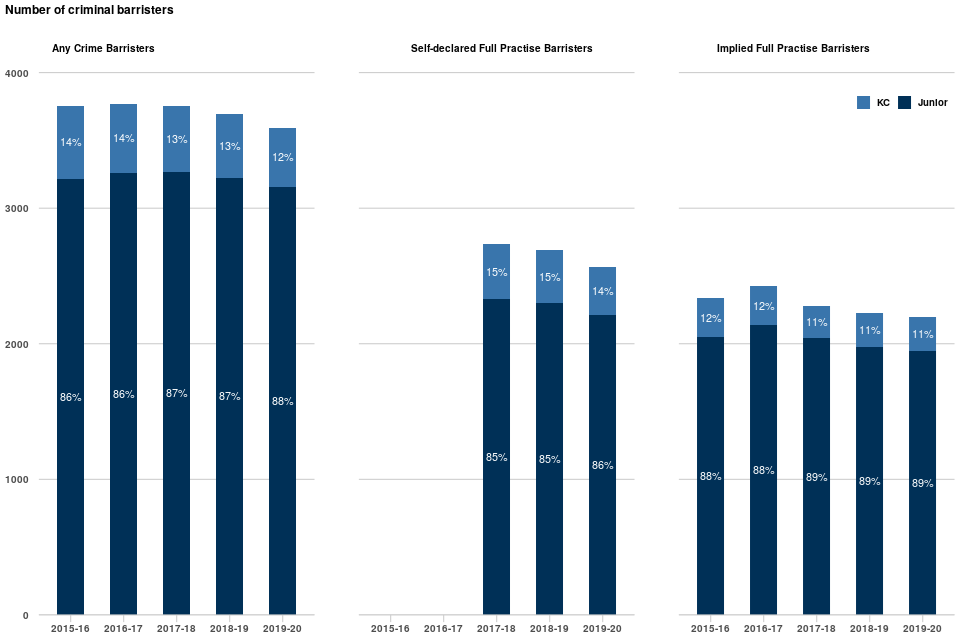
This section examines the characteristics of publicly-funded self-employed criminal barristers in England and Wales, acquired by matching of barristers’ public billing data, as held by the Legal Aid Agency and Crown Prosecution Service, with their corresponding characteristic information held by the Bar Council and Bar Standards Board. For this purpose, barristers are classified into three distinct groups: * the Any Crime group: comprised of barristers who received any criminal fee income in the year being considered. * the Self-declared Full Practice group: a subset of the ‘Any Crime’ group, indicating barristers must have self-declared to the Bar Council that at least 80% of their gross fee income in the respective year came from criminal work, this group is the main focus of this analysis. * the Implied Full Practice group: subset of the ‘Any Crime’ group, with the added condition that each barrister’s fee income from public criminal work must be equal to at least 80% of the lower bound of their total self-reported gross fee income band, which is reported to the BC each financial year.
Any Crime group Barristers
Across the years included here, over half of the public criminal fee income were received by AC barristers based in London; this proportion increased from 51% in 2015-16 to 55% in 2019-20. A much greater proportion of the barristers are of White background, at 82% which remained consistent over the years considered with Black/Asian/Minority Ethnic at 11% and those with an unknown ethnicity accounting for the remaining 7%.
Over the financial years considered, the distribution of public criminal fee income earned by AC barristers remained consistent with males earning 75% and women earning 23% (gender was unknown for 2% of fee income). In 2015-16, £22.2m of public criminal fee income was earned by barristers with 28 years and above years of practice, of which 92% and 7% was earned by men and women, respectively. The earning by barristers with 28 years and above years of practice increased to £66.4m in 2019-20, of which 88% was earned by men and 11% was earned by women.
Additionally, a wide variation exists in the public criminal fee incomes, for AC barristers. Exploring the Year of practice categories, the lower quartile, median and upper quartile of barristers with 8 to 12 Year of practice were £23K, £59k and £89.4k respectively, in 2015-16. The lower quartile, median and upper quartile of their earnings increased to £28.5k, £69.3k and £101.6k, respectively in 2019-20.
Self-declared Full Practice Barristers
It is worth noting that the self-reported percentage of a barrister’s gross fee income derived from criminal work commenced in 2017. Hence, the analysis of this group is limited to financial years starting from 2017-18.
The majority of the barristers in this group were based in London (56%) in 2019-20. Similar to the AC barrister group, the distribution of white, ethnic minority and solicitors without ethnicity information, remained consistent at 81%, 12% and 7%, respectively.
In 2019-20, £61.9m of public criminal fee income was earned by barristers with 28 years and above years of practice, of which 88% and 11% was earned by men and women, respectively. The distribution of public criminal fee income earned by female SFP barristers increased slightly from 22% in 2017-18 to 24% in 2019-20, associated with a decline of income earned by male from 76% in 2017-18 to 74% in 2019-20 (gender was unknown for 2% of fee income). The lower quartile, median and upper quartile of SFP barristers with 8 to 12 Year of practice were £60.8, £82.8k and £109.8k respectively, in 2019-20.
Further information
Our statisticians regularly review the content of publications. Development of new and improved statistical outputs is usually dependent on reallocating existing resources. As part of our continual review and prioritisation, we welcome user feedback on existing outputs including content, breadth, frequency and methodology. Please send any comments you have on this publication including suggestions for further developments or reduction in content.
National Statistics status
National Statistics status means that official statistics meet the highest standards of trustworthiness, quality and public value. All official statistics should comply with all aspects of the Code of Practice for Official Statistics.
They are awarded National Statistics status following an assessment by the Authority’s regulatory arm. The Authority considers whether the statistics meet the highest standards of Code compliance, including the value they add to public decisions and debate.
It is the Ministry of Justice’s responsibility to maintain compliance with the standards expected for National Statistics. If we become concerned about whether these statistics are still meeting the appropriate standards, we will discuss any concerns with the Authority promptly. National Statistics status can be removed at any point when the highest standards are not maintained, and reinstated when standards are restored.
Contact
Press enquiries should be directed to the Ministry of Justice press office:
Tel: 020 3334 3536 Email: newsdesk@justice.gov.uk
Other enquiries about these statistics should be directed to the Justice Statistics Analytical Services division of the Ministry of Justice:
Carly Gray, Ministry of Justice Tel: 07784 275495 Email: statistics@justice.gov.uk
Tables and Data
-
A set of Tables, which give further detail and full time-series for each scheme and interactive versions can be found for Crime and Civil.
-
An ods spreadsheet download for all ‘Tables’, which provide full time-series for each scheme.
-
Also an accessible version of ods spreadsheet download for all ‘Tables’, which also provide full time-series for each scheme.
-
Main data and Civil detailed data: Detailed files to enable independent analysis, provided in .csv (Comma delimited) format.
-
Diversity data and Provider data: Client characteristics data and Providers starts and completions by area and legal aid schemes are provided in .csv (Comma delimited) format.
-
Provider contracts data: Criminal and Civil legal aid provider contracts data are provided in .csv (Comma delimited) format.
Help
-
User Guide to legal aid statistics: This provides comprehensive information about data sources as well as key legislative changes.
-
Index of data in Legal aid statistics: A guide to the data published in the .ods files, lists of available data from Legal Aid systems and guidance on how to work with the data.
-
Quality Statement: This provides detail on how legal aid statistics meet user needs
Web tool
- List of Data visualisation tools A list of the web-based tools across the legal aid statistics release.
- Main visualisation tool A web-based tool allowing the user to view and customize charts and tables based on the published statistics.
Next update: 28 September2023
URL: https://www.gov.uk/government/collections/legal-aid-statistics
© Crown copyright Produced by the Ministry of Justice
Alternative formats are available on request from statistics@justice.gov.uk
